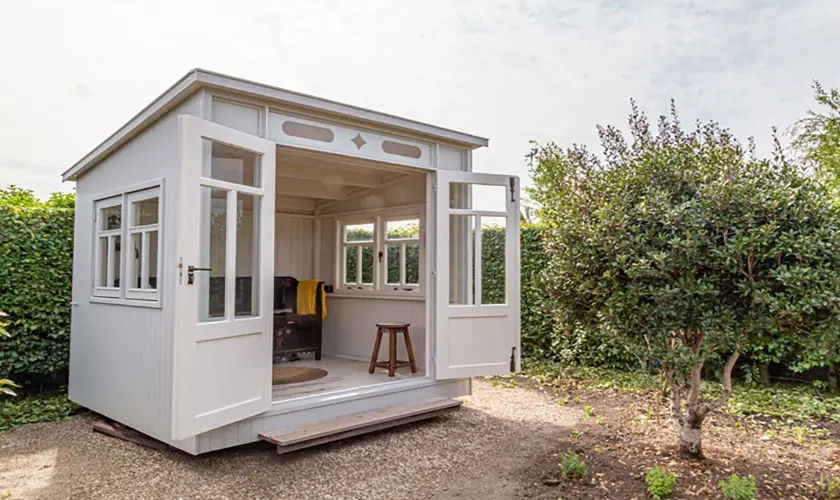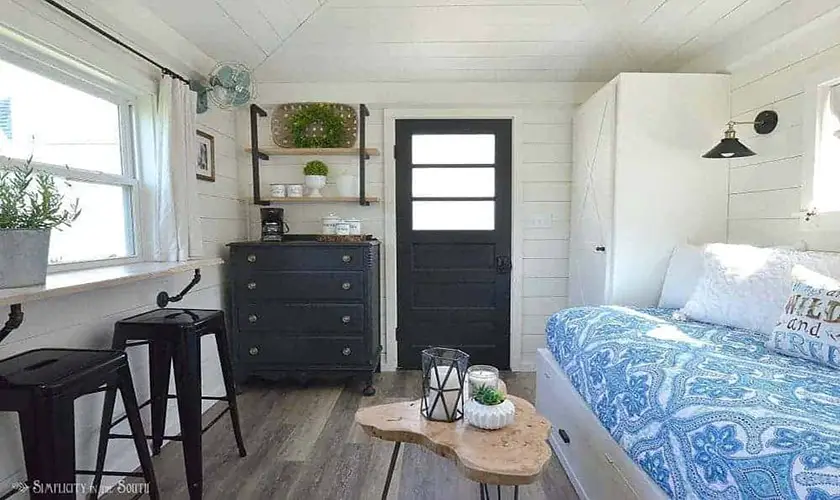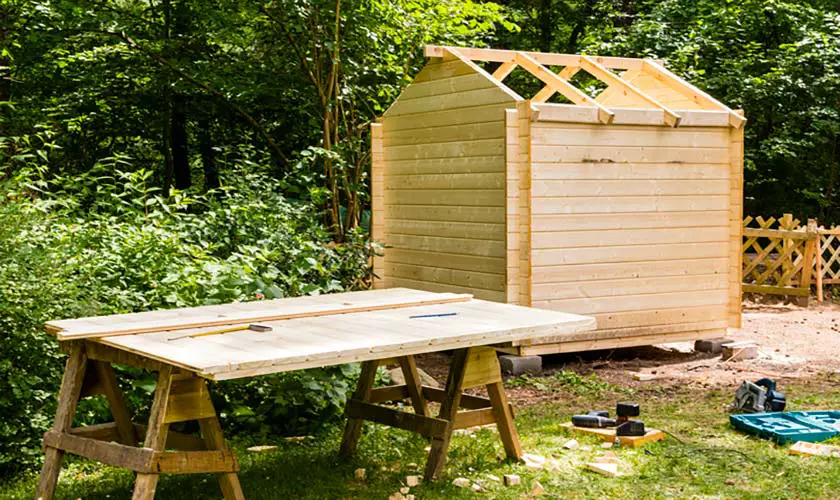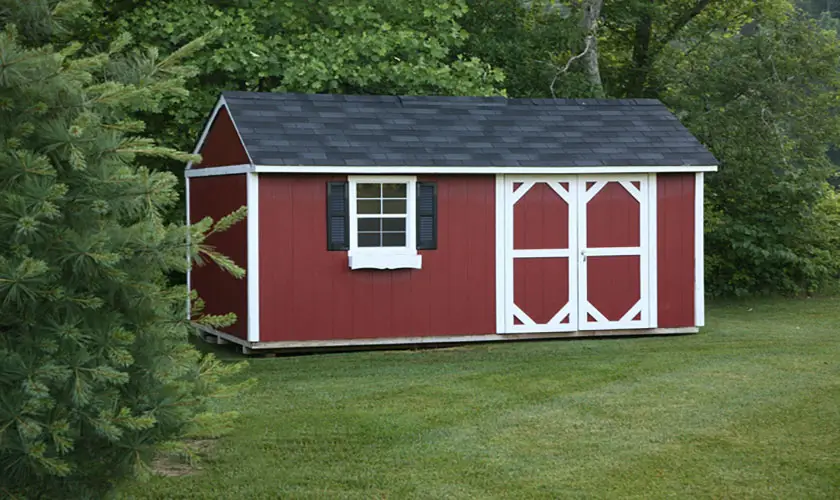
She sheds are a relatively new concept, but it’s also growing in popularity. She shed costs more than backyard sheds because they are often finished spaces for relaxation.
They’re a great way to get away from the main house when you need a break from work or family, but they’re also a good option for starting a home business. She sheds allow you to turn a standard storage shed or garden shed into your home office, art studio, craft room, or a quiet space to regain your sanity.
Regardless of what you want to use a she shed for, it’s crucial to figure out a budget for the project. The average cost of she sheds can range from $3,000 to $30,000, depending on how basic or extreme you want to be. To be on the safe side, however, you should plan on spending at least $7,000 to $13,000.
If your husband has a man cave, it’s only fair that you have your own space. What better way to do it than with a backyard shed that’s enough to give you your own space but not too far from home. If you’re ready to take the plunge and invest in a she shed, this article will give you all the pricing and cost details you need to know.
Average She Shed Cost
On average, she sheds cost between $3,000 for a basic, bare shed and up to $30,000 or even more for a fully custom shed. As the she shed trend becomes more and more prevalent, they’re getting more expensive and customized. People are starting to use she sheds for their hair salons, private office, or even as a guest house.
The biggest thing that will determine the price of your shed is if you buy one, build one yourself, or have someone else make it for you. By doing all the work yourself and using pre-used materials and your tools, you can build a simple shed for as little as $300. However, to have your shed professionally custom built and splurge on materials and accessories, you can run the price upwards of $40,000.
Buying a She Shed Versus Building Your Own
There are perks to building your own shed versus buying a shed. By building a shed, you have the opportunity to customize it to your liking and add or leave out certain features. Whereas if you buy a pre-fabricated shed, there’s a limit to how many customizations you can do. You’re forced to work within the boundaries of the shed you purchased.
Regarding the total cost, it’s cheaper to build your shed if you do the work yourself than buying a shed. However, buying a pre-fabricated shed will probably be cheaper if you hire a contractor to custom-build your shed. Labor costs are a killer when it comes to building a shed.
Shed Kits
If you lack experience with construction but don’t want to buy a pre-fab shed or hire a pro, you can also buy a shed kit. Shed kits will include everything you need to build your shed, from the materials to the hardware and instructions. However, shed kits won’t include any of the tools you need, so you’ll either have to rent or borrow them if you don’t already have them.
Shed Plans
An integral part of shed kits is the plans that come with them. The shed plans include a detailed list of steps and instructions to help you build your shed from start to finish. Shed plans should also list the materials and tools needed to complete the job. Most shed plans will cost anywhere from several hundred to a thousand dollars, depending on how big and detailed the shed is.
If you want to save significant money, you can opt for a free shed plan. The downside of free shed plans is that they often don’t include all the steps or details you need to complete your she shed. They might be detailed enough for an experienced construction worker but not for a greenhorn who doesn’t have any building experience.
In summary, the cheapest way to build a she shed is with a free shed plan where you buy all the materials necessary for the job. Next would be to purchase a shed kit with a shed plan and all the materials and instructions necessary for your shed. The third-cheapest option is to buy a pre-fabricated shed, but this leaves little room for customization. The final and most expensive she shed option is to have your shed custom-built from start to finish.
Factors That Affect the Price
Now that you have a general idea of what a she shed costs, let’s look at the four main factors affecting your total cost.
Size of the Shed
As with most things in life, the bigger and better you build your shed, the more it will cost. The price for a small shed measuring less than 100 square feet, whether pre-fabricated or built, is substantially less than a massive new shed. While square footage means more space to work with, it also means a higher price tag on your she shed.
Materials Used
The materials you use to build your shed will also play a massive role. The bigger and more expensive your shed materials are, the higher the cost will be. For example, plastic sheds and vinyl sheds are cheaper than metal sheds, brick sheds, or wood sheds.
However, the cheaper your materials are, the more likely your shed will experience issues. Cheap materials tend to break down faster than costly materials, and you might pay more for repairs and replacements than you would use expensive materials in the first place.
- Brick
Brick is far and away the most expensive building material for a she shed. It’s also not a very practical option since it means that your shed is a permanent structure that you will never be able to move. Brick she sheds costs around $15,000 to $30,000 for the materials and labor, depending on the size of the shed.
- Metal
Metal is another seldom-used she-shed material, but it’s ultimately an option. Metal is lightweight and easy to work with, but it’s somewhat flimsy and unreliable.
- Wood
You can use many different types of wood with your she shed. Wood is an excellent way to add a natural, homey look to your shed, but it’s also more expensive and prone to damage than other materials. Depending on the wood you choose, you could pay between $2,000 and $10,000 for the materials alone.
- Vinyl
Vinyl is quickly becoming the preferred shed material. Vinyl is pretty affordable, easy to work with, and very durable. Typically, you’ll use vinyl siding on top of OSB or a plywood shed frame. Depending on size, this she shed cost between $1,000 and $10,000.
- Plastic
Plastic usually isn’t a material you build a shed with, but it’s a material that many pre-fabricated sheds consist of. Plastic sheds can cost between $500 and $3,000.
Style of the Shed
The style of shed you build will also play a significant role in the overall cost. The price will be less for a basic, square, or rectangular shed. However, you can expect to pay more across the board for more intricate sheds in a Tudor, schoolhouse, or another style. The more basic the design and layout, the cheaper your shed will be.
Permits and Labor Costs
- Building Permits
Another thing to consider with the size of your shed is that you might need a building permit if the shed is a specific size. It’s essential to check your local building code with your building inspector before starting work on your she shed. In general, however, the bigger your shed is, the more likely you need a building permit.
Building permits for sheds aren’t as expensive as for houses, but you could easily be looking at $50 to $150, depending on where you live.
- Electrical Permits
If you plan to run electricity to your she shed, you’ll also have to pull an electrical permit if you want your shed to be up to code. Electrical permits could be another $40 to $100.
- Plumbing Permits
If you haven’t noticed yet, nothing is free when it comes to building or installing a shed on your property. Depending on your location, plumbing permits will cost another $50 to $100.
- Labor Costs
Labor costs are the main thing that will kill your budget when building a she-shed. Most carpenters and builders charge between $70 and $120 per hour, and a shed could take days or weeks to build. Labor costs alone could be anywhere from $2,000 to $10,000, depending on the size and difficulty of your shed.
And that’s just for building the shed, walls, roof, and internal structure. If you need to hire an electrician, a plumber, and an HVAC technician, you’re looking at several thousand additional dollars in labor costs.
The Different Components of a She Shed
Just as there are different factors in the overall size and style of the shed that affect price, you can add many different components to your she shed that will increase the price. Depending on what you plan to use your extra space for, you will need all of these additions.
Flooring
Depending on the size and style of your shed, flooring could be a huge expense or a minor one. For small storage sheds or seldom-used spaces, cheap flooring is the way to go. However, if you plan on using your she shed often for business purposes or as a studio shed, flooring isn’t something you want to skimp on.
While it’s important to save money where you can and not install flooring that’s overkill, you also want to install the right kind of flooring. Hardwood, bamboo, and vinyl floors are more expensive materials than linoleum or plywood, but they will provide more class and comfort. The intended use of your shed is the main thing to consider when choosing your flooring.
Insulation
Regardless of what you plan to do with your she shed, you should always install some insulation. The degree and type of insulation you choose will depend on how much time you spend in the shed, but it’s always necessary.
- For the Ceiling
Insulation above your ceiling in the attic area is the best way to keep warm air inside your shed and the cold air outside. Hot air naturally rises, which means if you have a heater, the heat it produces will go straight through your ceiling and out of your shed.
- For the Walls
If your walls aren’t insulated, your shed will struggle to maintain a steady temperature. During the summer, your shed will feel hot and humid; during the winter, your shed will be cold.
- For the Floors
Installing a layer of foam insulation beneath your floors or in your floor joists is a great way to take the chill out of your shed. The last thing you want is for your feet to get cold every time you enter your backyard retreat, and the best way to do that is with floor insulation.
Foundation
Your foundation is one of the most important components of your overall shed project. It will determine how solid and sturdy your shed is. You should invest in a concrete foundation for the best and most permanent solution. Concrete is the best option if you plan on leaving your shed in the same spot forever and not moving it.
However, shed skids are another good option if you don’t want things set in stone. Building your shed on skids means you can move it from place to place if you’re unsure where you want it located.
Excavation
Depending on the size of your shed and if you need to clear land for it, you might also be looking at excavation costs. Excavation, like labor costs, is an absolute budget slayer. You can easily pay between $500 and $2,000 to have your land excavated, plus your yard will be a disaster.
The cost and damage of excavating are part of why some people prefer a simple foundation for their she shed. Using skids or floor joists is a great option if you want a solid foundation that will not blow your budget or ruin your yard.
Electrical Wiring
As mentioned earlier, an electrical permit alone will cost around $50 to $100. Unless you have electrical experience, you’ll also have to hire a professional electrician to run electricity from your home to the shed. You’ll also have to pay them to install outlets, lights, and other electrical appliances in your shed.
Here’s a rough breakdown of what electrical wiring, labor, and components will cost.
- Electrical wiring
The cost of wiring alone is around $2 per foot, but it’s much more expensive for larger wires. For example, the electrical cable that will run from your home to the breaker box in your shed will cost closer to $5 per square foot.
- Lights
There’s a broad price range when it comes to lights. Most newer lights are LED, which means they’re more expensive to purchase but are extremely efficient. You can pay anywhere from $10 for basic light bulbs and sockets to several hundred dollars for more detailed and intricate light fixtures.
- Outlets
Outlets are one of the cheapest electrical fixtures you’ll spend money on, costing around $2 per outlet and outlet cover. For bigger or GFCI-protected outlets, however, you could spend between $10 and $20 per outlet.
- Appliances
Electrical appliances can mean anything from a small washer/dryer to a water heater or HVAC system. The more appliances you have and the bigger they are, the more electrical wiring you’ll need in your shed. Hair salons, for example, will use a ton of electricity, whereas a craft room or backyard retreat will use much less.
- Breaker Box
If you have enough electrical appliances, outlets, and lights, there’s a good chance that you’ll need a separate breaker box or disconnect in your she shed. If you can bypass the need for a breaker box and circuit breakers, you can save up to $1,000 for raw materials and installation.
Water
Just as electricity will cost extra money, so will water. The labor cost could be around $500 to $1,000 if you don’t do the work yourself. It will require trenching for a water supply line to go out to the shed and a drainage system running from the shed to your septic tank. It’s hard work to do it yourself, but it’s manageable if you’re not afraid of an intense DIY project.
- Drain Pipes
Drain pipes cost around $3 per foot for PVC pipes, which is the preferred drain pipe in today’s world of plumbing. The glue and cleaner you’ll need will cost an extra $10 to $15, but it’s much cheaper than hiring a pro plumber. You can purchase everything you need at a home improvement store or a plumbing store.
- Water Supply
To supply water to your shed, you’ll have to run a ¾” to 1″ water line from your home to the shed. The size of the pipe depends on how much water you need. For a single bathroom, you can get away with a ½” or ¾” line, but a salon or shed with a bathroom and kitchen will require ¾” to 1″, which will cost double what a ½” line does.
- Water Heater or Softener
If you have running water in your shed, there’s a good chance you’ll need a water heater and softener. Softeners cost anywhere from $200 to $1,000, and water heaters cost between $600 and $2,000, depending on the size and type you purchase.
Climate Control
You may not need total climate control if you live in temperate climates with fairly mild winters and summers. In Florida, for example, the winters are very mild, which means you may be able to get by with a window air conditioner and a small electric heater. For maximum comfort and control, however, you may want to install a mini-split or alternative HVAC system with full heating and cooling capabilities.
Climate control is especially important for professional spaces such as a studio shed or office. However, if you just want a she shed for extra storage space, climate control can be foregone entirely.
Tools
If you don’t have all the power and hand tools you need to work with wood and build a shed, that will be another hefty cost. While renting tools is cheaper than buying them, it will still run your budget up. If you have a Home Depot or local home improvement store, they typically offer tool rentals based on hourly, daily, or weekly use.
Additional Features
If you want your shed to be a home office or a safe, quiet place to get away and read a good book, there are additional features you’ll need, such as a comfortable chair and cozy furniture. In general, any time you add extra features like a ceiling fan or French doors, the overall cost of your shed will increase little by little.
It will also drive up the cost if you want plenty of natural light and install numerous windows and skylights. While it will make your space feel more like home, it will also increase your budget and heating and cooling bills.
Related Questions
How much does it cost to build a she shed from scratch?
To build a she shed completely from scratch, you should plan to spend an average of $5,000 to $10,000. The cost may depend more or less on the factors listed in this article.
How much does it cost to turn an existing shed into a she shed?
If you already have an existing structure on your property and want to turn it into a she shed, it could be cheaper or more expensive. You’re looking at a higher renovation cost with a run-down old shed. With a well-managed shed that you simply need to tweak and add things to, you can turn it into a she shed for as little as $1,500.
How much does it cost to build a salon shed?
To build a salon shed, you’re looking at the typical cost of a shed, around $7,000, plus plumbing, electrical, and all your salon equipment. You could easily spend around $30,000 for a complete salon shed, which is cheaper than buying or renting a commercial space.
Final Thoughts
That’s a ton of information you just took in about the possible cost of your she shed. There are many different ways you can go if you want to save money or blow your budget. If money is a concern, the best way to save it is by doing the work yourself, repurposing used materials, and choosing affordable but quality materials. If you’re not worried about money, the sky’s the limit with how much you want to spend on your she shed.






